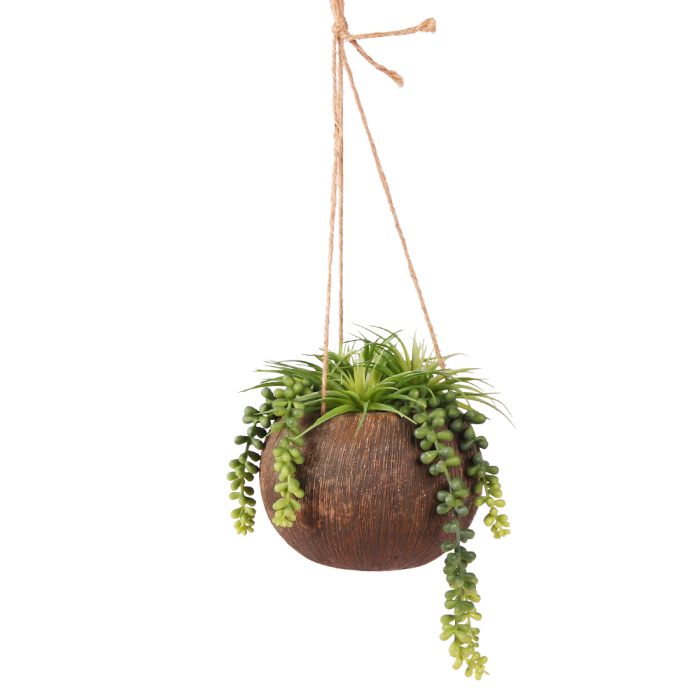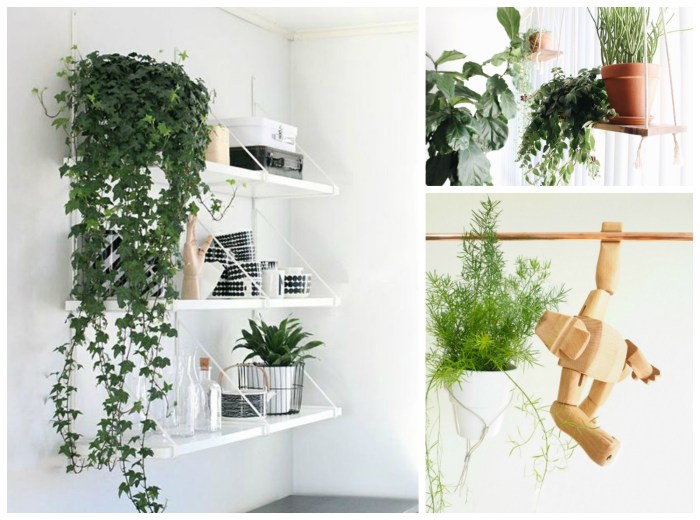Office hanging plants are not just decorative elements; they offer a myriad of benefits, transforming your workspace into a sanctuary of well-being and productivity.
From purifying the air to reducing stress levels, hanging plants create a more inviting and healthy environment for employees. This guide explores the world of office hanging plants, providing insights into their benefits, popular varieties, and essential care tips.
Popular Office Hanging Plants
Hanging plants have become increasingly popular in office spaces due to their ability to enhance air quality, reduce stress, and create a more inviting and productive work environment.
Here are some of the most popular hanging plants for office spaces:
Spider Plant
- Easy to care for, making them suitable for beginners.
- Produces “spiderettes” or baby plants that can be propagated to create new plants.
- Prefers bright indirect light and well-draining soil.
Pothos
- Known for its trailing vines and heart-shaped leaves.
- Tolerant of low light conditions and infrequent watering.
- Prefers well-draining soil and can be propagated from stem cuttings.
Golden Pathos
- Similar to Pothos but with golden-yellow leaves.
- Adds a splash of color to any office space.
- Prefers bright indirect light and well-draining soil.
String of Pearls
- Unique and eye-catching plant with trailing stems of bead-like leaves.
- Prefers bright indirect light and well-draining soil.
- Water sparingly, allowing the soil to dry out completely between waterings.
Burro’s Tail
- Features trailing stems of plump, fleshy leaves that resemble a burro’s tail.
- Prefers bright indirect light and well-draining soil.
- Water sparingly, allowing the soil to dry out completely between waterings.
Trailing Jade
- Compact and easy-to-care-for plant with trailing stems of succulent leaves.
- Prefers bright indirect light and well-draining soil.
- Water sparingly, allowing the soil to dry out completely between waterings.
Peperomia
- Small and compact plant with a variety of leaf shapes and colors.
- Prefers bright indirect light and well-draining soil.
- Water moderately, allowing the top inch of soil to dry out between waterings.
Hanging Plant Arrangements
Incorporating hanging plants into the office space offers a creative way to enhance aesthetics and purify the air. By arranging them strategically, you can create visually appealing displays that contribute to a harmonious and inviting work environment.
Choosing the Right Containers and Placement
Selecting suitable hanging containers is crucial for the well-being of plants and the overall visual appeal. Consider containers with drainage holes to prevent waterlogging and choose materials that complement the office decor, such as ceramic, metal, or macrame.
The placement of hanging plants should take into account the available space, natural light, and traffic flow. Avoid overcrowding areas and ensure plants receive adequate sunlight without obstructing walkways or workspaces.
Creating Visually Appealing Displays
To create visually appealing displays, experiment with different plant sizes, colors, and textures. Larger plants can serve as focal points, while smaller ones add variety and interest. Consider using a mix of trailing and upright varieties to create a dynamic effect.
Group plants together in odd numbers, such as three or five, for a more balanced and cohesive look. Arrange them at varying heights to create depth and visual intrigue.
Tips for Effective Arrangements
- Use a combination of trailing and upright plants to create visual interest.
- Group plants in odd numbers for a more balanced look.
- Hang plants at varying heights to add depth and intrigue.
- Consider the available space, natural light, and traffic flow when choosing placement.
- Select containers that complement the office decor and provide adequate drainage.
Plant Care and Maintenance

Ensuring the health and longevity of office hanging plants requires a tailored approach to care and maintenance. Understanding their specific requirements and implementing a consistent routine are essential for optimal growth and aesthetics.
Watering
Watering frequency depends on the plant species, pot size, and environmental conditions. Generally, hanging plants require watering when the top inch of soil feels dry to the touch. Overwatering can lead to root rot, while underwatering can cause wilting and stunted growth.
Fertilizing
Regular fertilizing provides essential nutrients for hanging plants. Use a balanced liquid fertilizer diluted to half strength and apply it every two to four weeks during the growing season. Avoid over-fertilizing, as this can burn the roots.
Office hanging plants can brighten up any workspace and improve air quality. For more information on the benefits of indoor hanging plants, visit Hanging Plants Indoor . These plants can add a touch of nature to your office and help create a more positive and productive environment.
Pruning
Pruning removes dead or damaged leaves and stems, encourages new growth, and maintains the desired shape of hanging plants. Use sharp, clean shears to make precise cuts, and prune regularly to promote a healthy and aesthetically pleasing appearance.
Pest and Disease Management
Hanging plants are susceptible to common pests and diseases. Regularly inspect plants for signs of infestation or infection. Use organic pest control methods such as neem oil or insecticidal soap to treat pests. For diseases, remove infected leaves and isolate affected plants to prevent spread.
Incorporating office hanging plants into your workspace can create a more inviting and productive environment. Amazon Plant Hangers Indoor: Elevate Your Greenery with Style and Functionality provides a curated selection of stylish and functional plant hangers that can help you elevate your office greenery, creating a more harmonious and inspiring atmosphere.
Plant Selection for Specific Office Environments

Choosing the right hanging plants for different office environments is crucial to enhance aesthetics and promote employee well-being. Factors such as light conditions, air circulation, and space availability should be considered.
Office hanging plants have gained popularity for their aesthetic appeal and air-purifying qualities. However, maintaining their health in indoor environments can be challenging. Wall Mounted Plant Grow Lights provide a solution by delivering precise lighting to enhance indoor greenery, promoting optimal growth and vibrancy.
With these innovative lights, office hanging plants can thrive, creating a healthier and more inviting workspace.
Open-Plan Offices
Open-plan offices often have ample natural light and air circulation. Hanging plants that thrive in these conditions include:
- Spider plants (Chlorophytum comosum): With their cascading foliage, spider plants add a touch of greenery to open spaces.
- Pothos (Epipremnum aureum): These easy-care plants tolerate low light and help purify the air.
- Snake plants (Sansevieria trifasciata): Known for their hardiness, snake plants require minimal light and water.
Cubicles
Cubicles typically have limited natural light and air circulation. Consider plants that can tolerate these conditions:
- ZZ plants (Zamioculcas zamiifolia): These low-maintenance plants thrive in low light and infrequent watering.
- Peace lilies (Spathiphyllum wallisii): Known for their air-purifying abilities, peace lilies prefer shady environments.
- Cast iron plants (Aspidistra elatior): As their name suggests, cast iron plants are incredibly resilient and can withstand low light and neglect.
Meeting Rooms, Office hanging plants
Meeting rooms require plants that create a welcoming and professional atmosphere:
- Ferns (Nephrolepis exaltata): Ferns add a touch of elegance and freshness to meeting rooms with their graceful fronds.
- Boston ferns (Nephrolepis exaltata ‘Bostoniensis’): These large ferns prefer bright indirect light and high humidity.
- Air plants (Tillandsia spp.): Air plants are unique and eye-catching, requiring no soil and absorbing nutrients from the air.
Designing with Hanging Plants

Hanging plants offer a unique and versatile way to enhance the aesthetics of an office space. By incorporating them into the design, businesses can create a more inviting and visually appealing environment that can boost employee well-being and productivity.
The impact of hanging plants varies depending on the design style of the office. In modern and contemporary spaces, they can add a touch of greenery and organic texture, complementing clean lines and minimalist decor. In traditional offices, they can provide a sense of warmth and elegance, softening the more formal atmosphere.
Incorporating hanging plants into office spaces has become increasingly popular, as they offer numerous benefits including improved air quality and reduced stress levels. Metal hanging planters, as detailed in the article Metal Hanging Planters for Indoor Spaces: Enhancing Aesthetics and Functionality , provide an elegant and durable solution for displaying plants in offices.
These planters enhance the aesthetics of the space while also ensuring the plants receive adequate sunlight and water.
In industrial-style offices, they can bring a touch of nature to the raw and exposed elements.
Visual Impact of Hanging Plants in Different Office Design Styles
| Design Style | Visual Impact |
|---|---|
| Modern | Adds greenery and organic texture, complementing clean lines and minimalist decor |
| Contemporary | Creates a sense of warmth and elegance, softening the more formal atmosphere |
| Traditional | Brings a touch of nature to the raw and exposed elements |
When choosing hanging plants for an office, consider the overall aesthetic of the space. Select plants that complement the existing decor and create a cohesive look. For example, in a modern office, opt for plants with clean lines and simple foliage, such as snake plants or ZZ plants.
In a traditional office, consider plants with more ornate foliage, such as ferns or ivy.
Hanging plants can also be used to create focal points or draw attention to specific areas of the office. For example, a large hanging plant can be placed in the reception area to create a welcoming atmosphere. Smaller hanging plants can be used to add a touch of greenery to individual workstations or meeting rooms.
Closing Summary
Incorporating office hanging plants into your workspace is a simple yet impactful way to enhance both the aesthetics and well-being of your team. By choosing the right plants and providing proper care, you can create a vibrant and thriving indoor oasis that inspires creativity and productivity.
Helpful Answers: Office Hanging Plants
What are the benefits of having hanging plants in the office?
Hanging plants improve air quality, reduce stress, enhance focus, and create a more inviting work environment.
What are the most popular hanging plants for office spaces?
Some of the most popular hanging plants for offices include pothos, spider plants, philodendrons, and ferns.
How do I care for hanging plants in my office?
Hanging plants require regular watering, proper lighting, and occasional fertilizing. Pruning is also essential to maintain their shape and health.